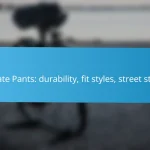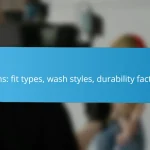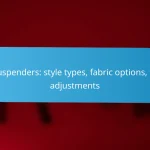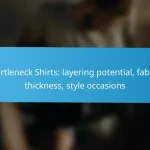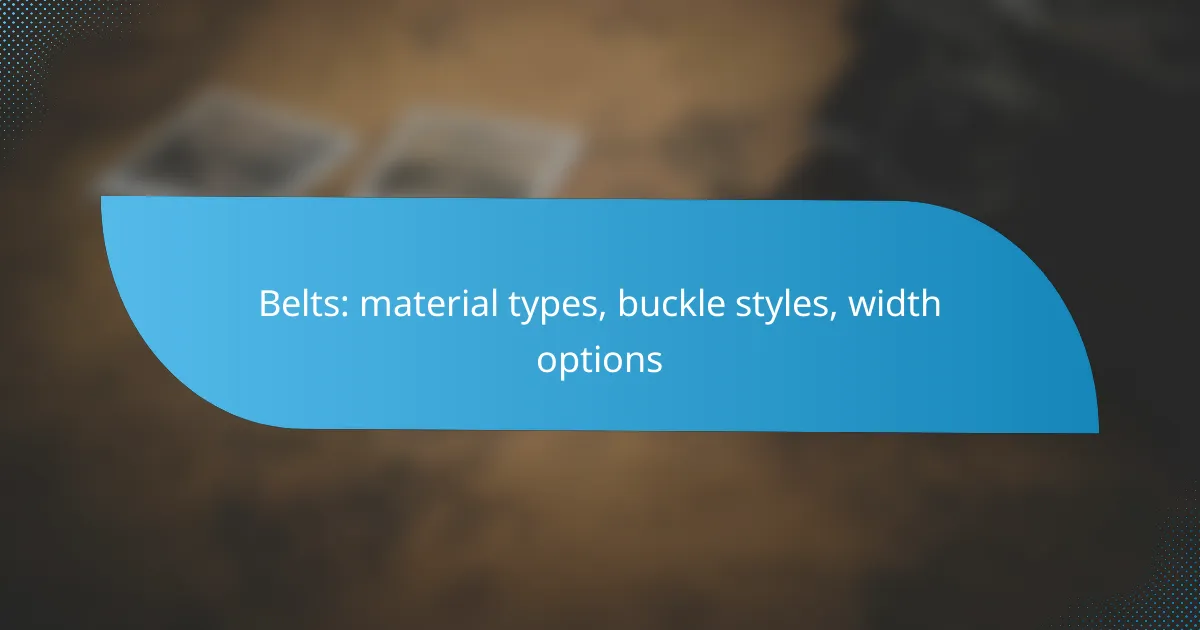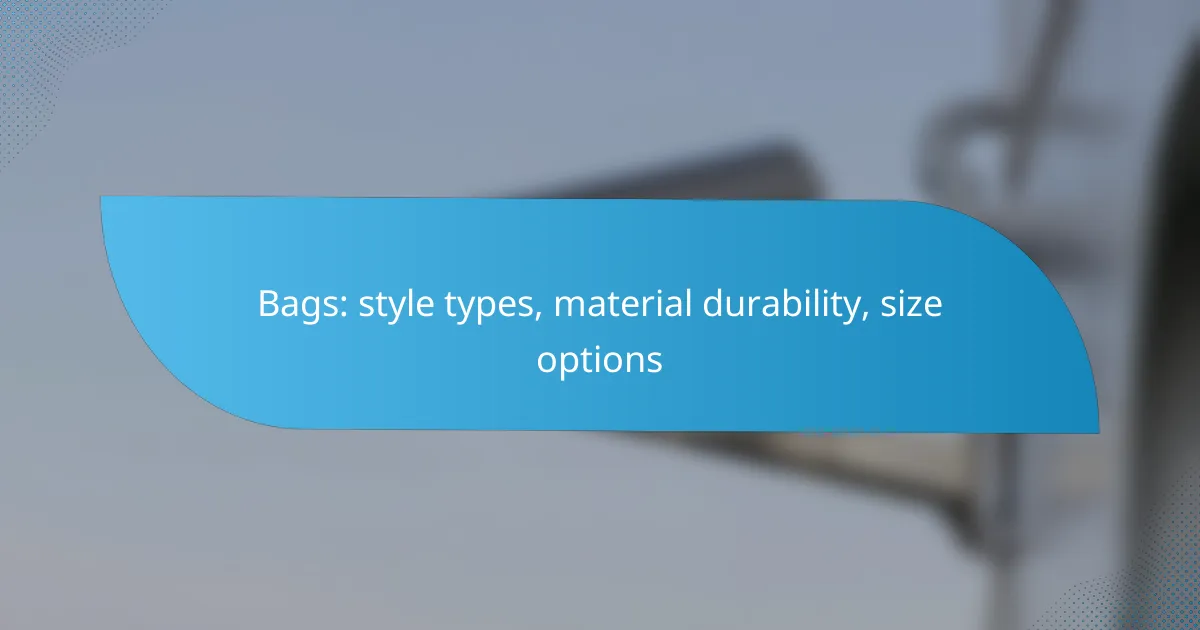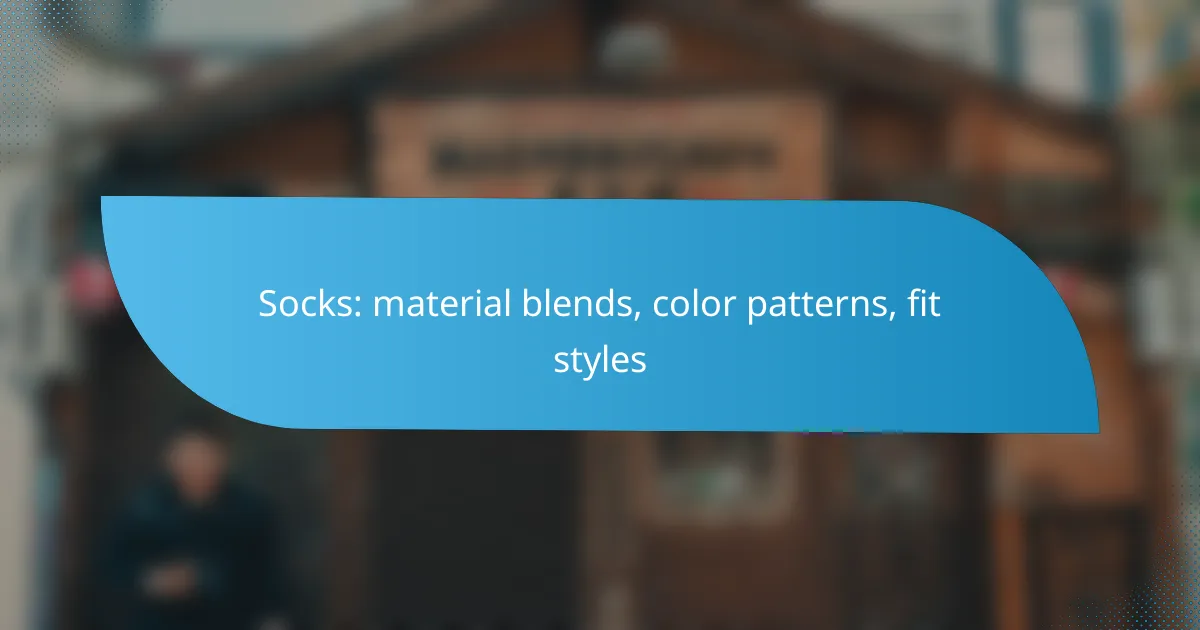Belts are essential accessories that come in a variety of materials, including leather, canvas, and nylon, each offering distinct advantages in terms of durability and comfort. The choice of buckle style can enhance your outfit while providing functionality, with options that cater to personal taste and practical needs. Additionally, belt widths typically range from 1 inch to 1.5 inches, influencing both style and usability for different occasions.
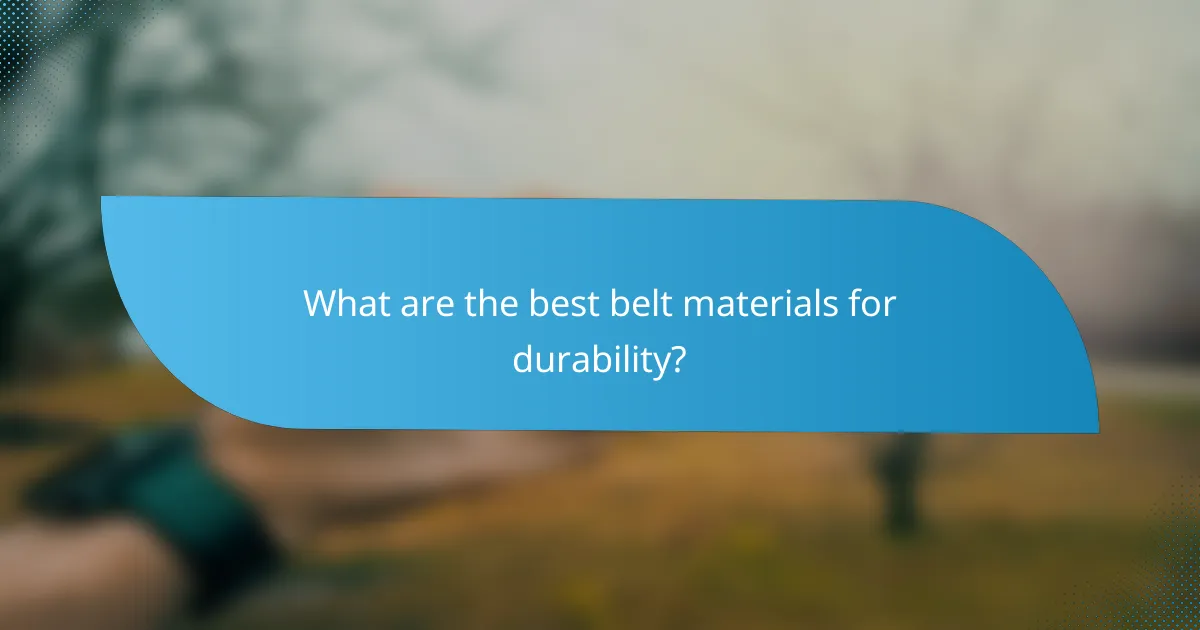
What are the best belt materials for durability?
The most durable belt materials include leather, canvas, polyester, suede, and nylon. Each material has unique properties that affect its longevity, comfort, and suitability for various uses.
Leather belts
Leather belts are renowned for their durability and classic appeal. Full-grain leather, in particular, is the strongest and ages beautifully, developing a unique patina over time. When choosing a leather belt, look for thick, high-quality leather to ensure longevity.
However, leather requires maintenance to prevent cracking and drying out. Regular conditioning with leather cream can extend its life significantly.
Canvas belts
Canvas belts are lightweight and often more affordable than leather. They are made from woven fabric, making them breathable and comfortable for casual wear. While they may not last as long as leather, high-quality canvas can withstand regular use.
These belts are typically machine washable, making them easy to maintain. Look for reinforced stitching to enhance durability.
Polyester belts
Polyester belts are synthetic and highly resistant to wear and tear. They are often used in outdoor and sports settings due to their strength and water resistance. These belts can handle rough conditions without losing their shape or integrity.
When selecting a polyester belt, check for UV resistance if you plan to use it outdoors frequently. This feature helps prevent fading and degradation from sunlight exposure.
Suede belts
Suede belts offer a softer texture and a stylish appearance, making them suitable for both casual and semi-formal occasions. While they can be durable, they are more susceptible to stains and water damage compared to other materials.
To maintain a suede belt, use a suede brush to remove dirt and a protective spray to guard against moisture. Avoid wearing suede in wet conditions to prolong its lifespan.
Nylon belts
Nylon belts are known for their exceptional strength and flexibility, making them ideal for outdoor activities and heavy-duty use. They are often adjustable and can be found in various styles, including tactical options.
These belts are typically resistant to abrasion and moisture, making them easy to clean. Look for belts with reinforced buckles for added durability during rigorous activities.

How do I choose the right buckle style?
Choosing the right buckle style depends on your personal preference, the intended use of the belt, and the overall aesthetic you want to achieve. Consider factors such as ease of use, durability, and how well the buckle complements your wardrobe.
Classic prong buckles
Classic prong buckles are the most traditional style, featuring a metal prong that fits into holes on the belt. They offer a secure fit and are easy to adjust, making them a popular choice for casual and formal belts alike. When selecting a prong buckle, ensure that the prong is sturdy and the holes are evenly spaced for optimal adjustability.
These buckles typically come in various materials, including stainless steel and brass, allowing you to match them with different belt styles. A classic prong buckle works well with leather belts, providing a timeless look.
Automatic buckles
Automatic buckles, also known as ratchet buckles, offer a modern alternative that allows for quick adjustments without the need for holes. Instead, they use a track system that secures the belt at any point, providing a customized fit. This style is particularly beneficial for those who prefer a precise fit or may experience fluctuations in waist size.
When choosing an automatic buckle, look for high-quality materials and a reliable locking mechanism to ensure durability. These buckles are often paired with leather or synthetic belts, making them versatile for both casual and business attire.
Box frame buckles
Box frame buckles feature a rectangular frame that holds the belt in place, often using a sliding mechanism. This style is less common but provides a unique aesthetic that can enhance the overall look of the belt. Box frame buckles are typically used in fashion-forward designs and can be made from various materials, including metal and plastic.
When selecting a box frame buckle, consider its compatibility with the belt material and width. This style works well with wider belts, adding a bold statement to your outfit.
Double prong buckles
Double prong buckles feature two prongs for added security and stability, making them an excellent choice for heavy-duty belts. This design distributes pressure more evenly, reducing the risk of the belt slipping or loosening during wear. Double prong buckles are often found on work belts or utility belts, where functionality is key.
When choosing a double prong buckle, ensure that it is made from durable materials to withstand regular use. This style pairs well with thicker belts and is ideal for outdoor activities or jobs requiring robust gear.

What are the width options for belts?
Belts come in various widths, typically ranging from 1 inch to 1.5 inches. The width you choose can affect both the style and functionality of the belt, making it important to consider your outfit and intended use.
Standard width (1.25 inches)
The standard width for belts is 1.25 inches, making it a versatile choice for both casual and formal wear. This width fits well with most belt loops and is widely accepted in various dress codes.
When selecting a standard-width belt, consider its compatibility with your wardrobe. It pairs nicely with dress pants, jeans, and chinos, providing a balanced look without overwhelming your outfit.
Wide width (1.5 inches)
Wide belts, measuring 1.5 inches, offer a bolder appearance and are often used in casual settings. They can make a statement and are commonly seen with jeans or casual trousers.
However, keep in mind that wide belts may not fit well in narrower belt loops, so check your pants before purchasing. They are also ideal for adding a touch of ruggedness to your look, especially when made from materials like leather or canvas.
Narrow width (1 inch)
Narrow belts, at 1 inch wide, are typically more suited for formal attire or lighter fabrics. They provide a sleek and refined look, making them perfect for dress shirts and tailored suits.
When opting for a narrow belt, ensure it complements your outfit without drawing too much attention. This width is often favored in professional settings, where subtlety is key.

What factors should I consider when selecting a belt?
When selecting a belt, consider the occasion, style, compatibility with your outfits, and comfort. These factors will help you choose a belt that not only fits well but also complements your wardrobe and meets your needs.
Occasion and style
The occasion significantly influences your belt choice. For formal events, opt for leather belts with simple, elegant buckles, while casual outings allow for more flexibility in materials and designs. Consider the overall style of your outfit to ensure the belt enhances your look.
Different styles of belts, such as woven or fabric options, can suit various casual settings. If you’re dressing for a business meeting, a classic black or brown leather belt is often the best choice.
Compatibility with outfits
Ensure your belt complements your outfits. A belt should match the color palette and style of your clothing. For instance, a brown leather belt pairs well with earthy tones, while a black belt is versatile for both formal and casual attire.
When selecting a belt, consider the width and buckle style in relation to your outfit. A wider belt may work well with casual jeans, while a narrower belt is typically better suited for dress pants.
Comfort and fit
Comfort is crucial when choosing a belt. Look for adjustable options or those with a good range of sizes to ensure a proper fit. A belt that is too tight can be uncomfortable, while one that is too loose may not hold your pants securely.
Consider the material as well; softer materials like fabric or suede can offer more comfort than rigid leather. Additionally, check the buckle style for ease of use, as some buckles may be more cumbersome than others.
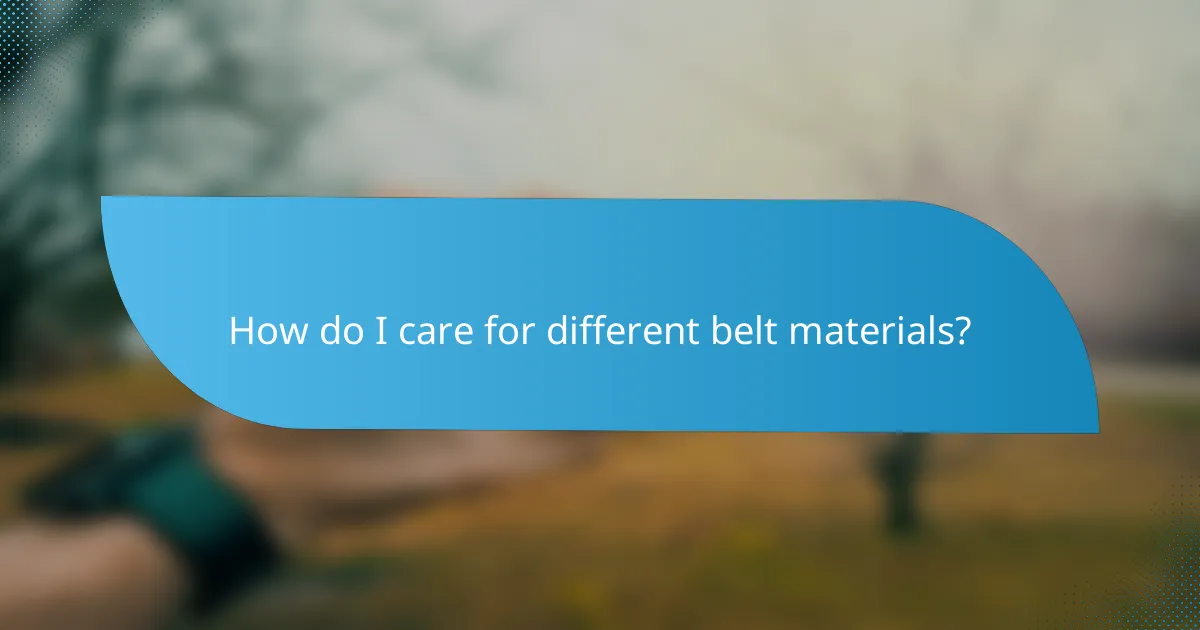
How do I care for different belt materials?
Caring for different belt materials involves understanding their unique properties and maintenance needs. Proper care can extend the lifespan of your belts and keep them looking their best.
Leather Belts
Leather belts require regular conditioning to prevent drying and cracking. Use a leather conditioner every few months to maintain suppleness. Avoid exposing leather to excessive moisture, as this can lead to damage.
When cleaning, use a damp cloth to wipe away dirt and stains. For deeper cleaning, consider a specialized leather cleaner. Always test any product on a small, inconspicuous area first.
Fabric Belts
Fabric belts, such as those made from cotton or polyester, are generally easier to care for. Most can be machine washed on a gentle cycle, but check the care label for specific instructions. Air drying is recommended to prevent shrinkage.
For stains, spot cleaning with mild detergent and water usually suffices. Avoid harsh chemicals that could damage the fabric or alter its color.
Canvas Belts
Canvas belts are durable and often machine washable. Wash them in cold water on a gentle cycle, and air dry to maintain their shape and color. Regular cleaning helps prevent dirt buildup and keeps the belt looking fresh.
To remove stubborn stains, a soft brush and mild soap can be effective. Always rinse thoroughly to avoid soap residue.
Synthetic Belts
Synthetic belts, made from materials like nylon or polyester, are typically low-maintenance. They can often be wiped clean with a damp cloth. For deeper cleaning, check if they are machine washable and follow the manufacturer’s guidelines.
Be cautious with heat; high temperatures can warp synthetic materials. Store them in a cool, dry place to avoid damage.
